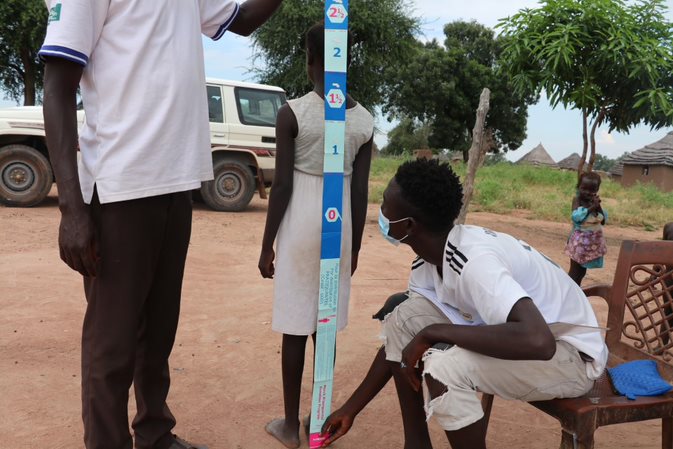South Sudan has undergone protracted conflict before and since gaining independence in 2011. More than 8 million of the country’s 13 million people will need humanitarian assistance in 2021 as a result of intensified intercommunal and sub-national conflict and violence, major flooding and the COVID-19 pandemic. Nearly half the population was facing high levels of acute food insecurity in March 2021, a proportion expected to grow by mid-year.1 The country has very poor health indicators including low life expectancy and poor access to health services. Government funding for health is low at less than 2% of the national budget, and out of pocket spending accounts for around 54% of total health expenditure. There is an acute shortage in the health workforce, inadequate health infrastructure and poor health service utilization.2

Measuring the height of young girl to determine her eligibility to receive the bilharzia treatment, South Sudan. ©WHO/Atem John Ajang
In recent years, the Government has been working to transition from a focus on humanitarian relief to longer-term development of the health sector, as reflected in 2017 Boma Health Initiative, a nationwide effort to integrate and improve access to fragmented, community health services, and the Health Sector Strategic Plan (HSSP) 2017–2022. The HSSP prioritizes delivery of a basic package of health and nutrition services through primary health care and financial protection for achieving Universal Health Coverage. A shorter-term Health Systems Stabilization and Recovery Plan for the period 2020–2022 is intended to serve as a catalyst for rebuilding the country’s health system and accelerating implementation of the HSSP by focusing on priority interventions to restore health system foundations, test approaches before scale-up, strengthen the humanitarian-development nexus and lay groundwork for further progress towards UHC and the health-related SDGs.
In December 2020, the South Sudan Ministry of Health presented priority challenges for scale up of PHC towards UHC to agencies in the GAP PHC accelerator working group. These included strengthening leadership and governance; health commodity and supply chain management; equitable service delivery; and community systems strengthening. Addressing human resources deficits for PHC is a particular challenge that requires prioritizing and improving remuneration, incentives and training for health workers and strengthening human resource information systems.
The Ministry has specifically requested that GAP agencies and other development partners:
- Align with the goals of the government-led HSSRP and strengthen the humanitarian-development nexus in health sector programming to foster PHC as the path to UHC;
- Commit to harmonization of resources around common PHC/UHC program implementation and monitoring;
- Help to strengthen national and subnational coordination platforms for joint action on PHC; and
- Consider a high-level, joint mission.
Although activities are at an early stage and progress has been delayed by COVID-19, GAP agencies and other partners are beginning to more closely align with the Government’s PHC priorities. Catalytic funding provided to the WHO country office has supported reactivation of the national Health Sector Working Group and efforts are underway to establish a PHC technical working group. Dialogue prompted by the GAP and facilitated by WHO and UNICEF country offices has led the Government towards committing to the concept of an equitable, PHC-led recovery from COVID-19 and generated further consensus among development partners in South Sudan – including the H6 group of agencies – about supporting national priorities in the Health Systems Stabilization and Recovery Plan.
The PHC accelerator working group agreed in February 2021 to create a South Sudan working group with representatives of GAP agencies at global and country levels to develop an action plan and map currently available financing against it.
References
- December 2020 integrated Food Security Phase Classification (IPC) report.
- Other data in this case study provided by WHO Country Office.
